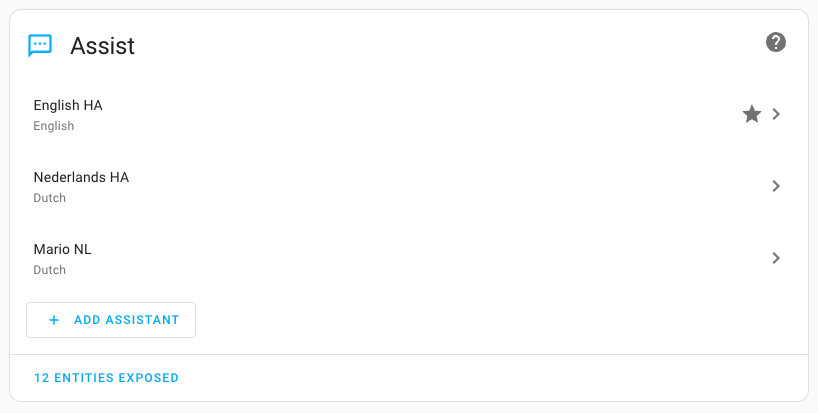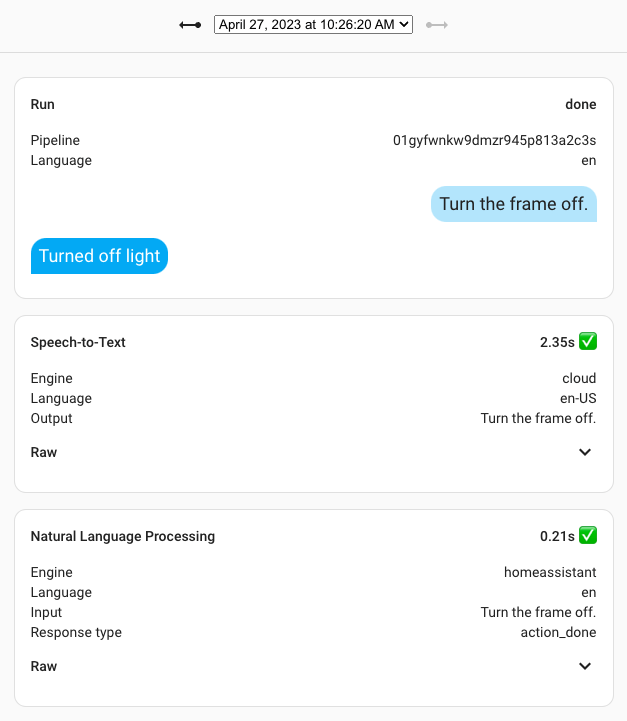Year of the Voice - Chapter 2: Let's talk
This year is Home Assistant’s Year of the Voice. It is our goal for 2023 to let users control Home Assistant in their own language. Today we’re presenting Chapter 2, our second milestone in building towards this goal.
In Chapter 1, we focused on intents – what the user wants to do. Today, the Home Assistant community has translated common smart home commands and responses into 45 languages
For Chapter 2, we’ve expanded beyond text to now include audio; specifically, turning audio (speech) into text, and text back into speech. With this functionality, Home Assistant’s Assist feature is now able to provide a full voice interface for users to interact with.
A voice assistant also needs hardware, so today we’re launching ESPHome support for Assist and; to top it off: we’re launching the World’s Most Private Voice Assistant. Keep reading to see what that entails.
To watch the video presentation of this blog post, including live demos, check the recording of our live stream.
Composing Voice Assistants
The new Assist Pipeline integration allows you to configure all components that make up a voice assistant in a single place.
For voice commands, pipelines start with audio. A speech-to-text system determines the words the user speaks, which are then forwarded to a conversation agent. The intent is extracted from the text by the agent and executed by Home Assistant. At this point, “turn on the light” would cause your light to turn on 💡. The last part of the pipeline is text-to-speech, where the agent’s response is spoken back to you. This may be a simple confirmation (“Turned on light”) or the answer to a question, such as “Which lights are on?”
 Screenshot of the new Assist configuration in Home Assistant.
Screenshot of the new Assist configuration in Home Assistant.
With the new Voice Assistant settings page users can create multiple assistants, mixing and matching voice services. Want a U.S. English assistant that responds with a British accent? No problem. What about a second assistant that listens for Dutch, German, or French voice commands? Or maybe you want to throw ChatGPT in the mix. Create as many assistants as you want, and use them from the Assist dialog as well as voice assistant hardware for Home Assistant.
Interacting with many different services means that many different things can go wrong. To help users figure out what went wrong, we’ve built extensive debug tooling for voice assistants into Home Assistant. You can always inspect the last 10 interactions per voice assistant.
 Screenshot of the new Assist debug tool.
Screenshot of the new Assist debug tool.
Voice Assistant powered by Home Assistant Cloud
The Home Assistant Cloud
As a subscriber, you can directly start using voice in Home Assistant. You will not need any extra hardware or software to get started.
In addition to high quality speech-to-text and text-to-speech for your voice assistants, you will also be supporting the development of Home Assistant itself.
Join Home Assistant Cloud today
The fully local voice assistant
With Home Assistant you can be guaranteed two things: there will be options and one of those options will be local. With our voice assistant that’s no different.
Piper: our new model for high quality local text-to-speech
To make quality text-to-speech running locally possible, we’ve had to create our own text-to-speech system that is optimized for running on a Raspberry Pi 4. It’s called Piper.

Piper uses modern machine learning algorithms
For more samples, see the Piper website
An add-on with Piper is available now for Home Assistant with over 40 voices across 18 languages
You can also run Piper as a standalone Docker container
Local speech-to-text with OpenAI Whisper
Whisper
An add-on using faster-whisper is available now for Home Assistant. On a Raspberry Pi 4, voice commands can take around 7 seconds to process with about 200 MB of RAM used. An Intel Core i5 CPU or better is capable of sub-second response times and can run larger (and more accurate) versions of Whisper.
You can also run Whisper as a standalone Docker container
Wyoming: the voice assistant glue
Voice assistants share many common functions, such as speech-to-text, intent-recognition, and text-to-speech. We created the Wyoming protocol
Wyoming allows developers to focus on the core of a voice service without having to commit to a specific networking stack like HTTP or MQTT. This protocol is compatible with the upcoming version 3.0 of Rhasspy
With Wyoming, we’re trying to kickstart a more interoperable open voice ecosystem that makes sharing components across projects and platforms easy. Developers and scientists wishing to experiment with new voice technologies need only implement a small set of messages to integrate with other voice assistant projects.
The Whisper and Piper add-ons mentioned above are integrated into Home Assistant via the new Wyoming integration. Wyoming services can also be run on other machines and still integrate into Home Assistant.
ESPHome powered voice assistants
ESPHome
Today we’re launching support for building voice assistants using ESPHome. Connect a microphone to your ESPHome device, and you can control your smart home with your voice. Include a speaker and the smart home will speak back.
We’ve been focusing on the M5STACK ATOM Echo
Tutorial: create a $13 voice assistant for Home Assistant.
ESPHome Voice Assistant documentation.
World’s Most Private Voice Assistant
If you were designing the world’s most private voice assistant, what features would it have? To start, it should only listen when you’re ready to talk, rather than all the time. And when it responds, you should be the only one to hear it. This sounds strangely familiar…🤔
A phone! No, not the featureless rectangle you have in your pocket; an analog phone. These great creatures once ruled the Earth with twisty cords and unique looks to match your style. Analog phones have a familiar interface that’s hard to beat: pick up the phone to listen/speak and put it down when done.
With Home Assistant’s new Voice-over-IP integration, you can now use an “old school” phone to control your smart home!
By configuring off-hook autodial, your phone will automatically call Home Assistant when you pick it up. Speak your voice command or question, and listen for the response. The conversation will continue as long as you please: speak more commands/questions, or simply hang up. Assign a unique voice assistant/pipeline to each VoIP adapter, enabling dedicated phones for specific languages.
We’ve focused our initial efforts on supporting the Grandstream HT801 Voice-over-IP box
Tutorial: create your own World’s Most Private Voice Assistant
Some links on this page are affiliate links and purchases using these links support the Home Assistant project.